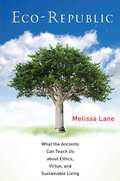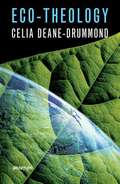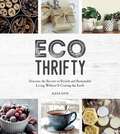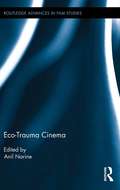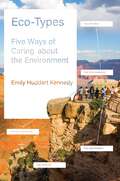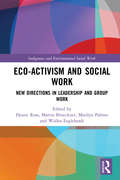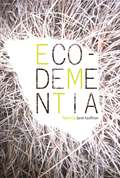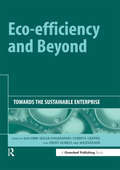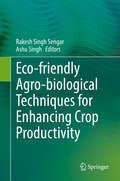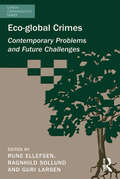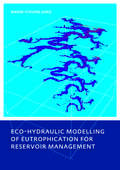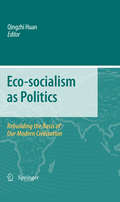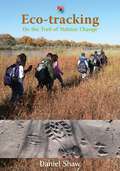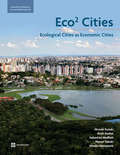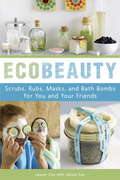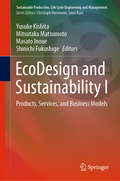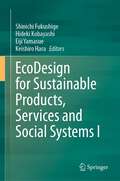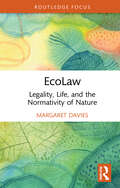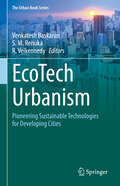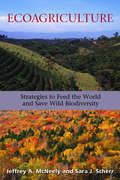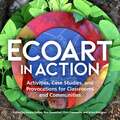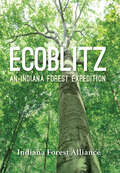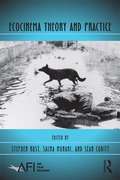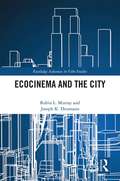- Table View
- List View
Eco-Republic: What the Ancients Can Teach Us about Ethics, Virtue, and Sustainable Living (Peter Lang Ltd Ser. #23)
by Melissa LaneAncient lessons for sustainable citizenshipAn ecologically sustainable society cannot be achieved without citizens who possess the virtues and values that will foster it, and who believe that individual actions can indeed make a difference. Eco-Republic draws on ancient Greek thought—and Plato's Republic in particular—to put forward a new vision of citizenship that can make such a society a reality. Melissa Lane develops a model of a society whose health and sustainability depend on all its citizens recognizing a shared standard of value and shaping their personal goals and habits accordingly. Bringing together the moral and political ideas of the ancients with the latest social and psychological theory, Lane illuminates the individual's vital role in social change, and articulates new ways of understanding what is harmful and what is valuable, what is a benefit and what is a cost, and what the relationship between public and private well-being ought to be.Eco-Republic reveals why we must rethink our political imagination if we are to meet the challenges of climate change and other urgent environmental concerns. Offering a unique reflection on the ethics and politics of sustainability, the book goes beyond standard approaches to virtue ethics in philosophy and current debates about happiness in economics and psychology. Eco-Republic explains why health is a better standard than happiness for capturing the important links between individual action and social good, and diagnoses the reasons why the ancient concept of virtue has been sorely neglected yet is more relevant today than ever.
Eco-Theology
by Celia Deane-DrummondHere is comprehensive coverage of the rapidly growing field of eco-theology. Eco-Theology evaluates the merits or otherwise of contemporary eco-theologies and introduces readers to critical debates, while tracing trends from around the globe and key theological responses. The emphasis is on the theological aspects of Christian engagement with environmental issues, rather than primarily ethical or spiritual concerns. Included are further reading sections and discussion questions.
Eco-Thrifty: Discover the Secrets to Stylish and Sustainable Living Without it Costing the Earth, Including Upcycling, Recycling, Budget-Friendly Ideas and More
by Alexa KayeLiving well doesn’t have to cost the earthWe all want to do our bit for the planet, and now it’s easier than ever. This book is your guide to eco-thrifty living: the way to look out for the climate and your budget at the same time. Explore the art of recycling and upcycling to spruce up your home and garden, find out how to revamp old clothes and how to say no to waste, and learn the secrets to conscious, creative living – all without the hefty price tag.There is no planet B, but with eco-thrifty living, we won’t need one. From nifty cleaning tips, to stylish home decor and natural beauty, discover the countless ways to reduce your carbon footprint and live a life you love that’s sustainable – both for the world and your wallet.
Eco-Trauma Cinema (Routledge Advances in Film Studies)
by Anil NarineFilm has taken a powerful position alongside the global environmental movement, from didactic documentaries to the fantasy pleasures of commercial franchises. This book investigates in particular film’s complex role in representing ecological traumas. Eco-trauma cinema represents the harm we, as humans, inflict upon our natural surroundings, or the injuries we sustain from nature in its unforgiving iterations. The term encompasses both circumstances because these seemingly distinct instances of ecological harm are often related, and even symbiotic: the traumas we perpetuate in an ecosystem through pollution and unsustainable resource management inevitably return to harm us. Contributors to this volume engage with eco-trauma cinema in its three general forms: accounts of people who are traumatized by the natural world, narratives that represent people or social processes which traumatize the environment or its species, and stories that depict the aftermath of ecological catastrophe. The films they examine represent a central challenge of our age: to overcome our disavowal of environmental crises, to reflect on the unsavoury forces reshaping the planet's ecosystems, and to restructure the mechanisms responsible for the state of the earth.
Eco-Types: Five Ways of Caring about the Environment
by Emily Huddart KennedyWhy acknowledging diverse eco-social relationships can help us overcome the political polarization that undermines our ability to protect the environmentWhen we picture the ideal environmentalist, we likely have in mind someone who dedicates herself to reducing her own environmental footprint through individual choices about consumption—driving a fuel-efficient car, for example, or eating less meat, or refusing plastic straws. This is a benchmark that many aspire to—and many others reject. In Eco-Types, Emily Huddart Kennedy shows that there is more than one way to care about the environment, outlining a spectrum of eco-social relationships that range from engagement to indifference.Drawing on three years of interviews and research, Kennedy describes five archetypal relationships with the environment: the Eco-Engaged, often politically liberal, who have an acute level of concern about the environment, a moral commitment to protect it, and the conviction that an individual can make a difference; the Self-Effacing, who share the Eco-Engaged’s concerns but not the belief in their own efficacy; the Optimists, often politically conservative, who are confident in their relationship with the environment, doubt the severity of environmental problems, and resent insinuations that they don’t care; the Fatalists, who are pessimistic about environmental decline and feel little responsibility to adopt environment-friendly habits; and the Indifferent, who have no affinity for any part of the environmental movement.Kennedy argues that when liberals feel they have a moral monopoly on environmental issues, polarization results. If we are serious about protecting the planet, we must acknowledge that we don’t all need to care about the environment in the same way.
Eco-activism and Social Work: New Directions in Leadership and Group Work (Indigenous and Environmental Social Work)
by Martin Brueckner Marilyn Palmer Dyann Ross Wallea EaglehawkSocial workers are called upon to shift from a human-centric bias to an ecological ethical sensibility by embracing love as integral to their justice mission and by extending the idea of social justice to include environmental and species justice. This book presents the love ethic model as a way to do eco-justice work using public campaigns, research, community arts practice and other nonviolent, direct action strategies. The model is premised on an active and ongoing commitment to the eco-values of love, eco-justice and nonviolence for the purpose of upholding the public interest. The love ethic model is informed by the stories of eco-activists who used nonviolent actions to address ecological issues such as: pollution; degradation of the environment; exploitation of farm animals; mining industry overriding First Nation Peoples’ land rights; and human health and social costs related to the natural resource industries, private land developments and government infrastructure projects. Informed by practice insights by activists from a range of eco-justice concerns, this innovative book provides new directions in social work and environmental studies involving transformational change leadership and dialogical group work between interest groups. It should be considered essential reading for social work students, researchers and practitioners as well as eco-activists more generally.
Eco-dementia
by Janet KauffmanJanet Kauffman describes “eco-dementia” as a paradoxical condition of humanity—a love of the living world while simultaneously causing and suffering from its destruction. Like other dementias, losses are profound. We lose touch, we forget. We don’t recognize our own home—the habitat that sustains us. What has driven us to exploit more and more resources, even when risking self-annihilation? Eco-dementia is not nature poetry, but an immersive language in the tangle of the living world that begs the question: can we survive this relationship? The poems in Eco-dementia took shape in one decade of the author’s life. In three sections, Kauffman reflects on insanities and devastations, from the personal to the global. From her father’s Alzheimer’s and the ravaged world of his mind to the horrors of Abu Ghraib, Hurricane Katrina, and toxins in Lake Erie, as well as the planetary-wide ecological catastrophe of climate change. Yet despite this devastation, it is possible to surround ourselves in light and air, to touch the tall grasses we love, to step into water and shade and feel an intense, momentary joy. Kauffman’s poems show the bliss within the elemental richness of the natural world and also the violent distortions and grief at its devastation. Like learning a new language, we can see and hear words, sometimes understanding so clearly and other times not at all. Or as Kauffman’s father puts it, “I know where you live, but I don’t know who you are.” The language of these poems is the physical material of a damaged world. Readers of modern and experimental poetry will treasure this collection.
Eco-efficiency and Beyond: Towards the Sustainable Enterprise
by Jan-Dirk Seiler-Hausmann Christa Liedtke Ernst Ulrich Von WeizsäckerBusiness-as-usual, it is widely accepted, will exceed the Earth's carrying capacity in an alarmingly short space of time. In simple terms, we need to learn to use the world's rapidly depleting resources in a significantly more efficient manner. Practical and readily adopted solutions are needed now. Eco-efficiency-or "produce more with less" – is achieved when goods and services satisfy human needs, increase the quality of life at competitive prices and when environmental impacts and resource intensity are decreased to a degree that keeps them within the limits of Earth's expected carrying capacity. Eco-efficiency – a term first proposed by the World Business Council for Sustainable Development in 1992 – is a management approach that allows businesses to carry out environmental protection measures from a market-oriented point of view, with the aim of illustrating that ecology and the economy do not need to be a contradiction. Indeed, eco-efficiency has been portrayed as a win-win-for both business and the environment. This book, which developed out of two conferences on eco-efficiency held in Düsseldorf in 1998 and 2001, is edited by Ernst Ulrich von Weizsäcker and his team from the Wuppertal Institute for Climate, Environment and Energy, one of the world's leading research programmes on resource productivity. The aim is not simply to explain the past and present of eco-efficiency but to look forward to and encourage a future where the comprehensive take-up of the concept by business, government and consumers could lead to innovation on a grand scale and the possibility of a giant leap beyond towards overall sustainability. There have been considerable achievements to date. The Dow Jones Sustainability Index, which aims to list the most sustainable corporations for investors, includes companies such as BASF, Climatex, Henkel and Matushita/Panasonic (all represented in this book), who are implementing eco-efficiency measures. A number of political initiatives have also been formed. In December 2001, the German government suggested a National Sustainability Strategy to measure Germany's sustainable development. While this not yet an accepted political target or even law, it shows that politics is moving toward binding targets for increasing efficiency. Eco-Efficiency and Beyond collects together the leading thinkers on the topic and aims to illustrate not only that the concept should be part of every business strategy but that it is a key trigger for innovation. Innovation cuts through paradoxes. It is the creation of solutions to conflicting demands. Flying in a vacuum gave us rockets and satellites; switching electrons through insulators gave us Silicon Valley and the digital age. Sustainable development presents a similar field of paradoxical innovation forces: i.e. provide affordable products and services for the growing unmet needs of the world population while reducing environmental impacts. This book is the definitive collection on eco-efficiency and will be required reading for business, government, NGOs and academicians.
Eco-friendly Agro-biological Techniques for Enhancing Crop Productivity
by Rakesh Singh Sengar Ashu SinghAs the world population is exploding and alongside fluctuations in climate is also prevalent, there is an increasing stress on the food requirements of the population. We have an urgent necessity to produce more food in the limited agricultural land. Further, to feed 7 billion people there is a requirement of high yielding crops, without harming environment and limiting the use of unnecessary pesticide and chemical fertilizers. Therefore it has become crucial to develop agri-bio-techniques which are environment friendly and also give high crop productivity. Many countries are evaluating the utility of biotechnology and its role in addressing problems of food security and poverty. Biotechnology is the application of scientific and engineering principles to the processing and production of materials by utilising biological agents. These agents are exploited to provide goods and services. Agricultural biotechnology encompasses a growing list of techniques that range from simple probes to determine a relevant gene from the complete genome to manipulating genes for a desired outcome. Many other popular methods used in the realm of agricultural technology are – gene integration, Marker-assisted breeding, Tissue culture, Gene profiling or association mapping, Metabolomics etc. The fundamental challenge facing the scientific community is how to devise innovative strategies that will bring all developed as well as developing countries into the “biological fold” and to do so in ways that will take full advantage of advances in the biological sciences to curb poverty, improve public health, and promote human development. This book contains information on eco-friendly techniques for high crop productivity and it is a myriad of different techniques and technology used to sustain productivity in crop plants. There are fewer books focusing on large-scale organic farming, molecular farming etc. Multidisciplinary research and literature is needed to deliver knowledge and products into the marketplace which fulfil these requirements. The present book is a collection of literature contributed by experts, scientists, professors, and researchers from around the world, it emphasizes work of concerned scientist and his choice of techniques used for enhancement of agricultural production. This book analyses the use of modern techniques to increase crop yields, production, and risk of hunger linked to socioeconomic scenarios.
Eco-global Crimes: Contemporary Problems and Future Challenges (Green Criminology)
by Ragnhild SollundBuilding on knowledge within the fields of green and eco-global criminology, this book uses empirical and theoretical arguments to discuss the multi-dimensional character of eco-global crime. It provides an overview of eco-global crimes and discusses them from a justice perspective. The persistence of animal abuse and speciesism are also examined together with policies aimed at controlling the natural world and plant species. Pollution by large corporations, rights of indigenous peoples and the damage caused by the mineral extraction are also considered. Providing new ideas and insights which will be relevant on a global scale, this book is an interesting and useful study of the exploitation of nature and other species. It will be invaluable for students and scholars globally, working within or connected to the field of green and eco-global criminology. The book will also be important for the participants of various social movements, especially the environmental and animal advocacy movements.
Eco-hydraulic Modelling of Eutrophication for Reservoir Management
by Nahm-chung JungThis study presents an systematic approach to water quality assessment, hybrid modelling and decision support for eutrophication management in deep reservoirs. It is found that during the summer monsoon the catchment runoff into the Yongdam reservoir induces a transfer of pollutants from a middle stratified layer to the surface layer. Although the
Eco-socialism as Politics: Rebuilding the Basis of Our Modern Civilisation
by Qingzhi HuanThis volume consists of analyses by experts from both the West and the East on the up-to-date development of Eco-socialism as a red-green politics within the context of capitalist globalisation. It investigates whether and/or in what sense Eco-socialism can offer a better explanation to the causes of ecological problems than the other Green discourses - such as deep ecology and ecological modernisation theory, and thus has more contributions to make in dealing with the deteriorating ecological crisis throughout the world.
Eco-tracking: On the Trail of Habitat Change (Barbara Guth Worlds of Wonder Science Series for Young Readers)
by Daniel ShawIn this much-needed work for our nation's youth, Daniel Shaw tracks the interconnections of small regional ecosystems to larger ones, and in the process demonstrates the accessibility of nature to everyone. As Shaw notes in his introduction, the story that is too often told about the environment is one about despair and destruction, which basically suggests to young people that all is lost and everything was better before their time. Instead, this book tells true life success stories of young people involved in citizen science efforts and how others can join in tracking climate change, local wildlife, and other parts of the natural world. Shaw's work demonstrates by example a story of hope for a natural environment that exists in the world. At the core of this book is the notion that humans are components of their ecosystems. Shaw encourages readers to learn what becomes of their outputs and to understand human contributions to various ecological cycles. Sidebars and activities give readers a chance to discover these cycles right in their backyards and to link their discoveries to neighborhood environments.
Eco2 Cities: Ecological Cities as Economic Cities
by Sebastian Moffatt Hinako Maruyama Hiroaki Suzuki Arish Dastur Nanae YabukiThe Eco2 Cities approach is a point of departure for cities that would like to reap the many benefits of ecological and economic sustainability. It provides an analytical and operational framework that offers strategic guidance to cities on sustainable and integrated urban development. At the same time case studies are used throughout the book to provide a matter-of-fact and ground-level perspective. The Eco2 framework is flexible and easily customized to the context of each country or city. Based on the particular circumstances and the development priorities of a city - the application of the framework can contribute to the development of a unique action plan or roadmap in each case. This action plan can be triggered through catalyst projects. To support this framework, the book also begins to introduce some powerful and practical methods and tools that can further enable sustainable and integrated city planning and decision making. These include 1) operational and process methods that can strengthen collaborative decision making and cross-sector synergies in a city; 2) analytical methods ranging from diagnostics, simulation, design and scenario-generation; and 3) accounting and benchmarking methods which can help clarify, define and measure what it means to truly invest in sustainability and resilience. As additional reference reading, the book also features a series of case studies from best practice cities around the world, each demonstrating a very different dimension of the Eco2 approach. It also features a series of infrastructure sector notes (on spatial development, transport, energy, water and waste management), each of which explore sector specific issues as they pertain to urban development, and the many opportunities for coordination and integration across sectors.
EcoBeauty
by Janice Cox Lauren CoxEcoBeauty has something for everyone. Crafty types will love the gift ideas, and even those of us who can barely make toast will be able to handle these recipes. Making beauty products at home is a great way to save money and help the environment, and these recipes will do all that plus give you gorgeous skin and hair. --Beth Mayall-Traglia, editor in chief of TotalBeauty.comFun, fresh bath and body recipes that are great for gifts, girls' nights, or everyday use!--Jill and Megan Carle, coauthors of Teens Cook and College CookingAttention DIYers! Finally, the ultimate natural-beauty "cookbook" packed with deliciously easy, eco-friendly recipes for getting gorgeous with fresh ingredients from the kitchen. A must-have for anyone who wants to be healthy, save money, and make the world a more eco-beautiful place.--Rona Berg, editor in chief of Organic Beauty magazine and author of Fast BeautyLotions and Toners and Soaps, Oh My!What's the hippest way to be green? When you whip up a batch of Avocado Hair Conditioner, not only will your hair be green (for about twenty minutes) but your lifestyle will, too. Natural beauty maven Lauren Cox is bringing bath and body into the eco-friendly future with 100 easy and economical projects, featuring au courant ingredients--hemp oil, green tea, soy milk, powdered kelp, goat's milk, and more--that are increasingly easy to find. Recycled bottling and green gift-giving ideas round out this stylish how-to manual for the DIY generation. So whether you are a crafty chica revitalizing your skin with an Espresso Yourself Facial Mask, a penny-pinching diva rocking some simple Green Tea Toner, or a chocoholic with a craving for Chocolate Brownie Lip Gloss, EcoBeauty has a money-saving, planet-loving, skin-pleasing creation for you.From the Trade Paperback edition.
EcoDesign and Sustainability I: Products, Services, and Business Models (Sustainable Production, Life Cycle Engineering and Management)
by Mitsutaka Matsumoto Shinichi Fukushige Yusuke Kishita Masato InoueThis book highlights cutting-edge ecodesign research, covering product and service design, smart manufacturing, and social perspectives in ecodesign. Featuring selected papers presented at EcoDesign 2019: 11th International Symposium on Environmentally Conscious Design and Inverse Manufacturing, it also includes diverse, interdisciplinary approaches to foster ecodesign research and activities. In the context of Sustainable Development Goals (SDGs), it addresses the need for the manufacturing industry to design innovations for sustainable value creation, taking into account technological developments, legislation, and consumer lifestyles. Further, the book discusses the concept of circular economy, which originated in Europe and aims to increase resource efficiency by shifting away from the linear economy. Focusing on product life cycle design and management, smart manufacturing, circular economy, and business strategies, and providing useful approaches and solutions to these emerging concepts, this book is intended for both researchers and practitioners working in the broad field of ecodesign and sustainability.
EcoDesign for Sustainable Products, Services and Social Systems I
by Shinichi Fukushige Hideki Kobayashi Eiji Yamasue Keishiro HaraThis 2-volume book highlights cutting-edge ecodesign research and covers broad areas ranging from individual product and service design to social system design. It includes business and policy design, circular production, life cycle design and management, digitalization for sustainable manufacturing, user behavior and health, ecodesign of social infrastructure, sustainability education, sustainability indicators, and energy system design. Featuring selected papers presented at EcoDesign 2021: 12th International Symposium on Environmentally Conscious Design and Inverse Manufacturing, it also includes diverse, interdisciplinary approaches to foster ecodesign research and activities. In the context of Sustainable Development Goals (SDGs), in particular SDG 12 (Responsible Consumption and Production), it addresses design innovations for sustainable value creation, considering technological developments, legislation, and consumer lifestyles. Further, the book discusses the concept of circular economy, which aims to develop circular business models for resource efficient society by taking advantage of digital technologies including artificial intelligence, internet of things, digital twin, data analysis and simulation. Written by experts from academia and industry, Volume 1 highlights sustainable design such as product and process design, collaborative design, sustainable innovation, digital technologies, design methodology for sustainability, and energy system design. The methods, tools, and practices described are useful for readers to facilitate value creation for sustainability.
EcoJustice, Citizen Science and Youth Activism
by Michael P. Mueller Deborah J. TippinsThis volume draws on the ecojustice, citizen science and youth activism literature base in science education and applies the ideas to situated tensions as they are either analyzed theoretically or praxiologically within science education pedagogy. It uses ecojustice to evaluate the holistic connections between cultural and natural systems, environmentalism, sustainability and Earth-friendly marketing trends, and introduces citizen science and youth activism as two of the pedagogical ways ecojustice philosophy can be enacted. It also comprises evidence-based practice with international service, community embedded curriculum, teacher preparation, citizen monitoring and community activism, student-scientist partnerships, socioscientific issues, and new avenues for educational research.
EcoLaw: Legality, Life, and the Normativity of Nature
by Margaret DaviesThis book re-imagines law as ecolaw. The key insight of ecological thinking, that everything is connected to everything else – at least on the earth, and possibly in the cosmos – has become a truism of contemporary theory. Taking this insight as a starting point for understanding law involves suspending theoretical certainties and boundaries. It involves suspending theory itself as a conceptual project and practicing it as an embodied and material project. Although an ecological imagining of law can be metaphorical, and can be highly imaginative and suggestive, this book shows that it is also literal. Law is part of the material ‘everything’ that is connected to everything else. This means that once the previous certainties of legal thinking have been dismantled, it is after all possible to think of law as ‘natural’ – as embedded in and emergent from a normative biophysical nature. The book proposes that there exists a natural nomos: animals, plants, and Earth systems that produce their own values and norms from which human norms and laws emerge. This book, then, proposes a new way to understand law, and pursues specific arguments to demonstrate the feasibility of law as ecolaw. Drawing inspiration from current trends in the post-humanities, socioecological thought, and developments across the natural sciences in their specific intersections with humanities and social science disciplines, this book will appeal both to legal theorists and to others with interests in these areas.
EcoTech Urbanism: Pioneering Sustainable Technologies for Developing Cities (The Urban Book Series)
by Venkatesh Baskaran S. M. Renuka R. VelkennedyIn a world experiencing unprecedented urbanization and drastic climate change, there is immense demand for creative solutions to the environmental, social, and economic obstacles faced by burgeoning cities in the developing world. This book delves into the potential of innovative urban initiatives to address the challenges of urbanization in countries with limited resources, thereby contributing to sustainable and inclusive urban development. It explores how cutting-edge technologies can provide efficient functionality for urban residents through information and communications shared among stakeholders. The primary aim is to enhance the efficiency of urban operations, foster economic development, and improve the well-being of residents by leveraging intelligent technologies and analyzing data. Government and policy are recognized as fundamental drivers of urban development, and the book sheds light on initiatives supporting cities that are not only technologically advanced but also sustainable, inclusive, and equitable. Contributions provide insight into technological aspects of urbanism, including the Internet of Things (IoT), sensors, data analytics, and essential infrastructure for sustainable city development. They also emphasize the importance of community engagement and inclusivity, stressing that urban initiatives should be designed for the benefit of all citizens, leaving no one behind. EcoTech Urbanism makes a compelling case for the imperative of sustainability in the future of urban areas, underscoring the critical role of technology in achieving this goal. The book offers a holistic perspective on the integration of eco-friendly technologies, fostering a balance between urban development and environmental conservation, ultimately paving the way for a future where cities thrive sustainably and inclusively.
Ecoagriculture: Strategies to Feed the World and Save Wild Biodiversity
by Jeffrey A. Mcneely Future Harvest Sara J. ScherrAlthough food-production systems for the world's rural poor typically have had devastating effects on the planet's wealth of genes, species, and ecosystems, that need not be the case in the future. In Ecoagriculture, two of the world's leading experts on conservation and development examine the idea that agricultural landscapes can be designed more creatively to take the needs of human populations into account while also protecting, or even enhancing, biodiversity. They present a thorough overview of the innovative concept of "ecoagriculture" - the management of landscapes for both the production of food and the conservation of wild biodiversity. The book:examines the global impact of agriculture on wild biodiversitydescribes the challenge of reconciling biodiversity conservation and agricultural goalsoutlines and discusses the ecoagriculture approachpresents diverse case studies that illustrate key strategiesexplores how policies, markets, and institutions can be re-shaped to support ecoagricultureWhile focusing on tropical regions of the developing world -- where increased agricultural productivity is most vital for food security, poverty reduction, and sustainable development, and where so much of the world's wild biodiversity is threatened -- it also draws on lessons learned in developed countries. Dozens of examples from around the world present proven strategies for small-scale, low-income farmers involved in commercial production.Ecoagriculture explores new approaches to agricultural production that complement natural environments, enhance ecosystem function, and improve rural livelihoods. It features a wealth of real-world case studies that demonstrate the applicability of the ideas discussed and how the principles can be applied, and is an important new work for policymakers, students, researchers, and anyone concerned with conserving biodiversity while sustaining human populations.
Ecoart in Action: Activities, Case Studies, and Provocations for Classrooms and Communities
by Amara Geffen, Ann Rosenthal, Chris Fremantle, and Aviva RahmaniReady-to-go, vetted approaches for facilitating artistic environmental projectsHow do we educate those who feel an urgency to address our environmental and social challenges? What ethical concerns do art-makers face who are committed to a deep green agenda? How can we refocus education to emphasize integrative thinking and inspire hope? What role might art play in actualizing environmental resilience?Compiled from 67 members of the Ecoart Network, a group of more than 200 internationally established practitioners, Ecoart in Action stands as a field guide that offers practical solutions to critical environmental challenges. Organized into three sections—Activities, Case Studies, and Provocations—each contribution provides models for ecoart practice that are adaptable for use within a variety of classrooms, communities, and contexts. Educators developing project and place-based learning curricula, citizens, policymakers, scientists, land managers, and those who work with communities (human and other) will find inspiration for integrating art, science, and community-engaged practices into on-the-ground environmental projects. If you share a concern for the environmental crisis and believe art can provide new options, this book is for you!
Ecoblitz: An Indiana Forest Expedition
by Indiana Forest AllianceA short hike through an Indiana forest reveals layers of living things: the overstories and understories of trees, the shadow of a mammal, colorful fungi. But what would it mean to methodically document the communities of plants and animals harboring in Indiana's public forests, at humid midnight or coldest dawn? What is the impact of this wondrous knowledge?Ecoblitz describes the findings of, and the dogged scientists behind, the Indiana Forest Alliance's multiyear forest wildlife census. Scientists' journeys in pursuit of elusive bats, lavish lichen, and spider species paint a breathtaking picture of Indiana's biodiversity and its value to Indiana's policy, polity, and poetics. This book will amaze readers with a dazzling portrait of local biodiversity, deepen appreciation for Indiana's eastern hardwood forest system, and inspire a desire to advocate for it. Ecoblitz is a book for lovers of nature, for those who appreciate science but are not scientists themselves, and for those who want to learn something new.
Ecocinema Theory and Practice (AFI Film Readers)
by Sean Cubitt Stephen Rust Salma MonaniEcocinema Theory and Practice is the first collection of its kind—an anthology that offers a comprehensive introduction to the rapidly growing field of eco-film criticism, a branch of critical scholarship that investigates cinema’s intersections with environmental understandings. It references seminal readings through cutting edge research and is designed as an introduction to the field as well as a sourcebook. It defines ecocinema studies, sketches its development over the past twenty years, provides theoretical frameworks for moving forward, and presents eloquent examples of the practice of eco-film criticism through essays written by the field’s leading and emerging scholars. From explicitly environmental films such as Werner Herzong's Grizzly Man and Roland Emmerich's The Day After Tomorrow to less obvious examples like Errol Morris's Fast, Cheap & Out of Control and Christopher Nolan's Inception, the pieces in this collection comprehensively interrogate the breadth of ecocinema. Ecocinema Theory and Practice also directs readers to further study through lists of recommended readings, professional organizations, and relevant periodicals.
Ecocinema in the City (Routledge Advances in Film Studies)
by Robin L. Murray Joseph K. HeumannIn Ecocinema in the City, Murray and Heumann argue that urban ecocinema both reveals and critiques visions of urban environmentalism. The book emphasizes the increasingly transformative power of nature in urban settings, explored in both documentaries and fictional films such as Children Underground, White Dog, Hatari! and Lives Worth Living. The first two sections—"Evolutionary Myths Under the City" and "Urban Eco-trauma"—take more traditional ecocinema approaches and emphasize the city as a dangerous constructed space. The last two sections—"Urban Nature and Interdependence" and "The Sustainable City"—however, bring to life the vibrant relationships between human and nonhuman nature. Ecocinema in the City provides a space to explore these relationships, revealing how ecocinema shows that both human and nonhuman nature can interact sustainably and thrive.
